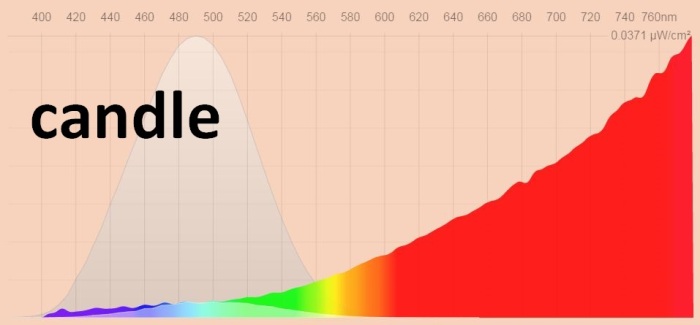Computer blue light can disturb our sharp vision thus causing eye strain which can be a problem for many people, particularly when it develops into chronic eye strain. This article explains why computer blue light negatively affects our sharp vision and why it can cause eye strain unless removed.
Disclaimer: I am NOT a vision scientist nor a physician but a more computer glare and light-sensitive person, hence my interest in why computer blue light causes eye strain.
Far more blue light than in natural light sources
Digital screens emit High Energy Visible (HEV) or blue light with high intensity when compared to the intensity of longer wavelengths emitted by the same screen.

Said differently, the composition of light – spectral power distribution (SPD) – emitted by screens is substantially different (image above: high energy peak in blue region) from the spectral characteristics of natural light sources (images below: the Sun – relatively uniform across the visible spectrum; Moon, fire/candle – lower blue light intensity compared to red). Images source: fluxometer.com.



Moreover, blue light intensity in light reflected from objects we view in nature is further attenuated: very few surfaces are naturally white or blue, meaning that they absorb blue light while reflecting other, longer wavelengths.
Researchers estimate that 5% to 12% of the population suffers from severe visual stress, and imply that high blue light content from artificial energy-saving light sources is to be blamed for the majority of the cases [Levels of visual stress in proficient readers: Effects of spectral filtering of fluorescent lighting on reading discomfort; 2015].
Unfortunate color selection in GUI design makes things worse
On average computer screens tend to emit blue light with much greater intensity largely because the predominant color in most GUIs is white. To make it worse, white is often combined with blue.
Compare SPD of a screen displaying only white, only blue, only green, or only red and note the overpowering peak in the blue wavelength region in the case of the first two.
The dominance of white and blue on our screens is unfortunate because, for a sizeable proportion of the population, other colors would be more comfortable and less likely to induce eyestrain.
Blue light disturbs sharp vision
Our sharp vision is not sensitive to blue light. Yet, we need precision vision to perform visual computer tasks. Fovea centralis, the very center of our retina, is responsible for central, sharp vision. The photoreceptors there are the most sensitive to green and red light, but not blue. This means that blue light that reaches our fovea centralis is redundant and makes images less clear.
Moreover, blue light that reaches sharp vision photoreceptors is out of focus. Our lens’ function is to focus light on fovea centralis. But, when light passes through the lens, it bends differently at different wavelengths. The refractive index for blue light is sufficiently different from red and green that when they are in focus, the blue is slightly out of focus (chromatic aberration). Obviously, the lens favors green and red light, since fovea centralis is most sensitive to green and red wavelengths. This works very well in the great majority of natural environments because (as established above) reflected light that enters our eyes tends to be less intense in the blue range and more in green and red.
Blue light also scatters more than longer wavelengths when it passes through the eye media. Thus it induces glare disability and discomfort glare at lower intensity levels [The visual effects of intraocular colored filters; 2012].
Hence, blue light, when dominant relative to longer wavelengths as in the case of digital displays (and energy-saving light sources), may reduce contrast and make things appear hazy, glary and out of focus unless we have an effective macular pigment.
Low macular pigment: a source of blue light sensitivity
To reduce or eliminate blue light from reaching our sharp vision photoreceptors our eyes contain a natural blue light filter called macular pigment. When optimal, macular pigment is far superior to artificial blue light filters because:
– it is a blue light filter with spectral transmission adapted to the needs of the photoreceptors immediately behind it
– it acts as an anti-oxidant thus protecting our photoreceptors from oxidative damage
– it is strategically positioned in the eye such that it doesn’t interfere with photoreceptors for blue light and photoreceptors for low light conditions, which are also most sensitive in the blue wavelength range.
An artificial blue light filter might have the first of the above characteristics (though I have not yet found one), but never the latter two.
However, our macular pigment may be too weak to cope with computer emitted blue light. Macular pigment optical density – MPOD varies considerably from person to person, principally based on age and diet [Enhancing performance while avoiding damage: A contribution of macular pigment (2013)].

Since macular pigment is repleted through dietary intake, one way how to prevent eye strain induced by blue light might be to boost the proportion of green, leafy vegetables in your diet or to take dietary supplements that strengthen our macular pigment.
Note also that low macular pigment is not the only reason for greater blue light sensitivity. In fact even people who are visually blind, but retain non-image forming photoreceptors, may experience light sensitivity. In these cases blue light also induces the symptoms at lower intensity levels than longer wavelengths of light. Hence filtering blue light has proven beneficial, however, the exact causal mechanism is still not well understood [Photophobia in a blind patient: an alternate visual pathway – Case report (2006), Diagnosis, pathophysiology, and treatment of photophobia (2016)].
